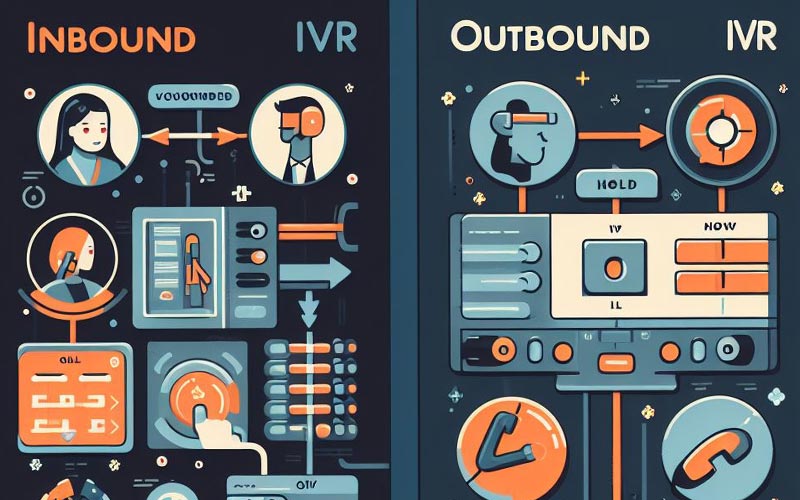Inbound IVR vs Outbound IVR
IVR, or Interactive Voice Response, is a technology that has become an integral part of modern communication systems. It’s a versatile tool that enhances interactions between businesses and their customers. One of the distinctions within the IVR realm is between inbound and outbound IVR. What are these two, and how do they differ? In this guide, we’ll explore the characteristics and applications of inbound IVR and outbound IVR to help you understand which one is the right fit for your business.
Understanding IVR Basics
Before we dive into the differences between inbound and outbound IVR, let’s get a grasp of what IVR technology is all about.
What is IVR?
Interactive Voice Response (IVR) is a technology that allows for automated interactions with callers through pre-recorded voice menus and touch-tone keypad selection. IVR systems are designed to assist with various tasks such as call routing, information inquiries, and transaction processing, all without requiring the assistance of a live operator.
The Versatility of IVR
IVR systems are highly versatile and can be customized to suit various business needs. They find applications in multiple industries, from customer support in e-commerce to banking and healthcare services. Understanding the two primary categories of IVR – inbound and outbound – is crucial for implementing the right system for your organization.
Inbound IVR: Handling Incoming Calls with Finesse
Inbound IVR is designed to manage incoming calls from customers. It plays a pivotal role in streamlining the call handling process and providing a seamless experience to callers.
Characteristics of Inbound IVR
- Call Routing: Inbound IVR efficiently routes calls to the right department or agent. For instance, a customer calling a technical support line can navigate through an IVR menu to reach the appropriate support representative.
- Self-Service: It empowers customers to find information or complete tasks independently, such as checking account balances, tracking orders, or making payments.
- Personalization: Inbound IVR can identify callers based on their phone numbers, allowing for a personalized experience by retrieving their relevant data.
- Queue Management: In cases of high call volumes, inbound IVR can manage waiting times by offering call-back options or providing estimated wait times.
- Integration: Inbound IVR systems are often integrated with Customer Relationship Management (CRM) tools, ensuring seamless interactions.
Applications of Inbound IVR:
Inbound IVR is invaluable for applications like customer support hotlines, order status inquiries, and bill payment services.
Outbound IVR: Proactive Customer Engagement
Outbound IVR takes a more proactive role by initiating calls to deliver messages or gather information.
Characteristics of Outbound IVR
- Appointment Reminders: Outbound IVR can make automated calls to remind patients of upcoming medical appointments or clients of scheduled service visits.
- Surveys and Feedback: It’s used to conduct automated surveys, collect feedback, or gauge customer satisfaction.
- Delivery Notifications: Outbound IVR can provide delivery updates and shipping information to customers.
- Emergency Alerts: It plays a crucial role in delivering emergency notifications, like weather warnings and security alerts.
- Debt Collection: In the finance industry, outbound IVR can be employed to notify customers of overdue payments or collect debts.
Applications of Outbound IVR:
Outbound IVR is particularly useful in healthcare for appointment reminders, in logistics for delivery notifications, and in customer service for feedback collection.
The Key Differences
Now that we’ve explored the two types of IVR, let’s highlight the key differences between inbound and outbound IVR.
- Call Direction: Inbound IVR handles incoming calls from customers, while outbound IVR initiates outgoing calls to deliver messages or notifications.
- Customer Interaction: Inbound IVR primarily focuses on providing self-service options and routing calls efficiently. Outbound IVR, on the other hand, delivers information or gathers data via automated outbound calls.
- Use Cases: Inbound IVR is commonly used in customer support and service hotlines. Outbound IVR excels in proactive customer engagement and information dissemination.
Conclusion
Understanding the differences between inbound and outbound IVR is essential for leveraging the full potential of this technology. By choosing the right type of IVR for your business needs, you can enhance customer interactions, improve operational efficiency, and provide a higher level of service. Whichever path you choose, the world of IVR holds significant opportunities for businesses of all sizes. Ready to implement IVR for your organization? Get in touch with a reliable IVR service provider to kickstart your journey into enhanced customer communication.

